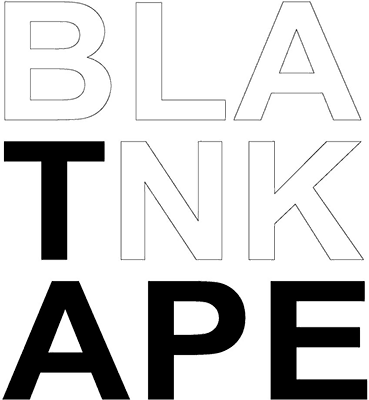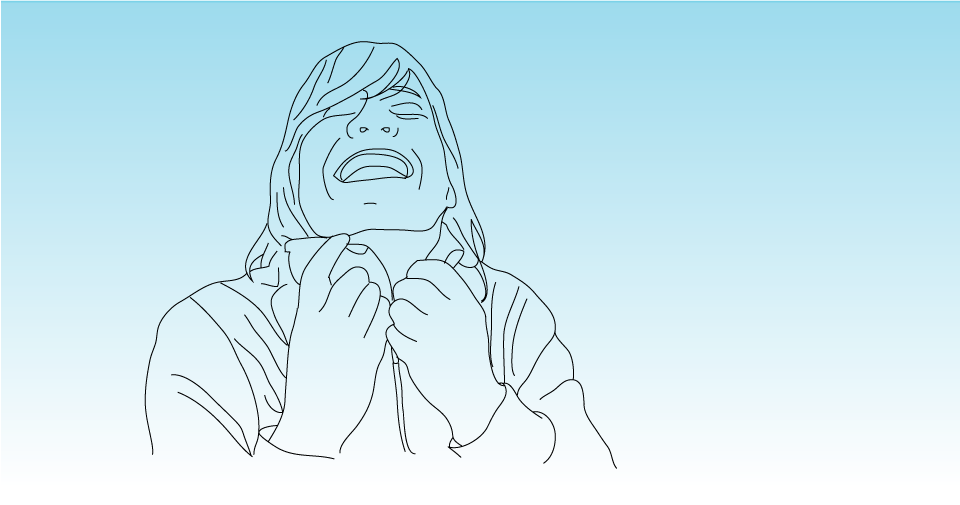
|
INTERVIEW Brígida Baltar by Paulo Mendel collaborator Mariana Abasolo drawing Paulo Mendel |
While re-reading a 2006 interview with artist Brigida Baltar, I was surprised by the connection between what we talked about back then with the theme of the current collective exhibition Of the website blanktape, homing \ roaming, four years later. In this never-before-published material, we went through issues such as freedom of media, conjectured about low-tech production with the arrival of HD, and approached the most frequent stimuli in an artist’s trajectory, and among those, home. It was only necessary to develop one question to prevent the redemption of this content from ignoring her most recent creations. And that was. The day before her trip to London, Brigida answered me regarding her experiences throughout |
Paulo Mendel – The collections of humidity — fog, dew and sea air — were developed in various media. You have explored drawings, photos, videos and films to unfold the theme for 10 years; perhaps for all these factors I consider this your most well-known work. How was this process?
Brígida Baltar – The first time I did the act of collecting moisture was in 1994, in a ranch in the most rural part of Saquarema1, where I used to go. I got up quite early to collect dew from the plants with my son, Tiago. It was a planned action; we had arranged a basket full of small bottles the night before, It was the extension of a work that I had already been doing in the house where I lived, Of collecting and storing in bottles the house’s roof drippings, dust, bricks, paint peels from the walls. My work essentially deals with the process of selection, storage, organization. I have more than one piece in which the bottles contain something that was gathered, and that is somehow connected with my existence. There is a bookstand with the house’s drippings, another one with brick dust, the clothing that I made to collect fog has various pockets than contain small bottles. At the time I also placed inside the bottles, large, torn drawings, several, and now I
am making a large bottle with almost all the information and photos, slides, etc., from some 1980s production. I think that this way of acting, perhaps of organizing myself, organizing the world, led me to this project that you say is my best-known work. This is because I decided to enhance these actions, to climb the mountains of Petrópolis2 more than once in search of the landscapes with the most special fog. The images that I was obtaining were amazing and then I also thought about the clothes that I could be wearing and what kind of film or technique I would choose to capture that atmosphere. so, that was how the project kept moving forward in time and naturally changing with it.
1 Translator ‘ s note: a town located in the state of Rio de Janeiro.
2 Translator ‘ s note: a town located in the state of Rio de Janeiro.

PM – You have also released a record with a composition that was created especially for this series. When was the song included in the project?
BB – I only presented the project in a more complete form in 2001, at Agora/Capacete, and on that moment, the song was included. I tried, in the first editions, to add some sounds, but I have always considered this limit a delicate one — when the music does not have its own conceptual space and it becomes merely illustrative or takes the form of a “soundtrack”. I did not want that. That is when the idea of making a record came up. It would be an independent way of presenting the video, which would also maintain the silence that the images requested. In 2001, I had the opportunity of traveling to some cities in Switzerland and Germany — the places I visited, the homes, everyone had a record player —, unlike here, where everyone was getting rid of their equipment. The record player and the vinyl were great reunions for me, a counter-hand technology in which I became interested, more intimate, with its own noises. The song was composed in partnership with Phil Canedo and talks with Dudu Candelot — it was a digital recycling Of the sound that was gathered from the act of collecting.
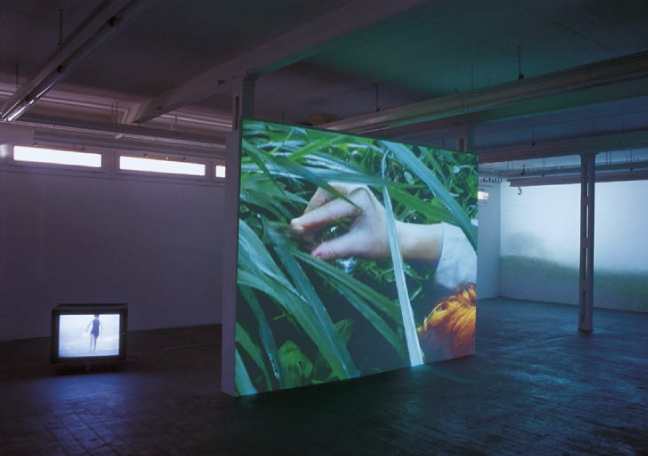
PM – What about the transfer of digital videos to 16mm film?
BB – Most Of the times I used a very simple digital video camera that in fact doesn’t really have high definition. What happens is that, nowadays, flat screen monitors have much more quality than the actual image capturing process provides. Even though I am using 16mm, I have depth and color improvement, but it becomes disappointing when the image is burned on a DVD, which is still a very limited medium.
I went through a great deal of suffering, I kept running a thousand tests, I wanted to understand everything, to interfere in all stages and burn the DVDs myself. I consulted many professionals, video production companies’ technical staff. and did the best I could, but the fog’s delicate nature gets somewhat lost in a sea of image noises. White always brings a texture in video. And afterwards you get a better result, but the projector must be good enough too, And then I wanted to understand more about projectors, low luminance, high luminance. The video cameras with capture quality such as the HD cameras are now arriving in the market. Current productions will have a different presentation than the ones made five years ago. That is why I still prefer small projectors and old tube monitors for my work. But there is a discussion behind all of this, which is the extent to which the image resolution matters so much. Video pieces made with digital photography cameras — which means with very simple definition — often outweigh due to the power of the work’s outcome, the actual concept, the choices of images and narrative structures.
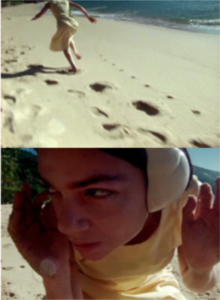 PM – The Maria Farinha / Ghost Crab process was somewhat different, at least with regard to production. It is a work that emerges between the series Coletas (Collections) and Casa de Abelha (Bee’s House). It was also the first time you worked with a slightly bigger crew, used an original soundtrack and did not utilize your Own image in the film. Above all, it was your first experience exploring the eyes, the face, which had been hidden by the mystery of humid atmospheres. Is there a stronger relationship with cinema in this piece?
PM – The Maria Farinha / Ghost Crab process was somewhat different, at least with regard to production. It is a work that emerges between the series Coletas (Collections) and Casa de Abelha (Bee’s House). It was also the first time you worked with a slightly bigger crew, used an original soundtrack and did not utilize your Own image in the film. Above all, it was your first experience exploring the eyes, the face, which had been hidden by the mystery of humid atmospheres. Is there a stronger relationship with cinema in this piece?
BB – With Maria Farinha, I wanted to experiment a very real production path, working with 16mm, forming a work team, etc. It was an experience. I think that in the case of Maria Farinha, music is a part of the narrative, for the character has those shell-shaped headphones, and that is where a type of sound that has to do with where her delusions comes from. Perhaps this is the connection with cinema that you’ve noticed — it is my most narrative work, closer to literature, to contemporary cinema. On the one hand it would be an overstatement to say that what I do is cinema. I prefer to think that it was onlv a medium that I used for this project. I wanted a different piece, given that I appear too much in the photos of the collections and in the book. It was then that I invited actress Lorena da Silva to play the character Maria Farinha / Ghost Crab. She did an impressive work, with great vigor.
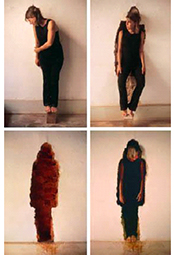 PM – Home is a recurring theme in your creations. Both the video and part of the Casa de Abelha (Bee’s House) photos were done at your former home-studio. You took bricks from this same house to create other videos, actions and Abrigo (Shelter), a hole in the wall in the shape of your body. WIth those bricks, you built towers, gardens, until you reached the powder that you use to draw and even to create mini bricks. Tell me more about the meaning of this space, of the home in your work.
PM – Home is a recurring theme in your creations. Both the video and part of the Casa de Abelha (Bee’s House) photos were done at your former home-studio. You took bricks from this same house to create other videos, actions and Abrigo (Shelter), a hole in the wall in the shape of your body. WIth those bricks, you built towers, gardens, until you reached the powder that you use to draw and even to create mini bricks. Tell me more about the meaning of this space, of the home in your work.
BB –It is amazing how important the home is to me! Actually I think that [it is important] for everyone… There is a philosopher. I will remember his name in a bit, who says that man is, while inhabiting, essentially an inhabiting being. It is definitely this issue that is the focus to me, in the works Abrigo, Casa de Abelha and even Maria Farinha / Ghost Crab. All this inspiration began in the Botafogo3 house, but the process goes on, when I kept gallons of brick powder from this house. I now use this powder to make my drawings, sculptures and spatial installations.
3 Translator ‘ s note: a neighborhood in the city of Rio de Janeiro.
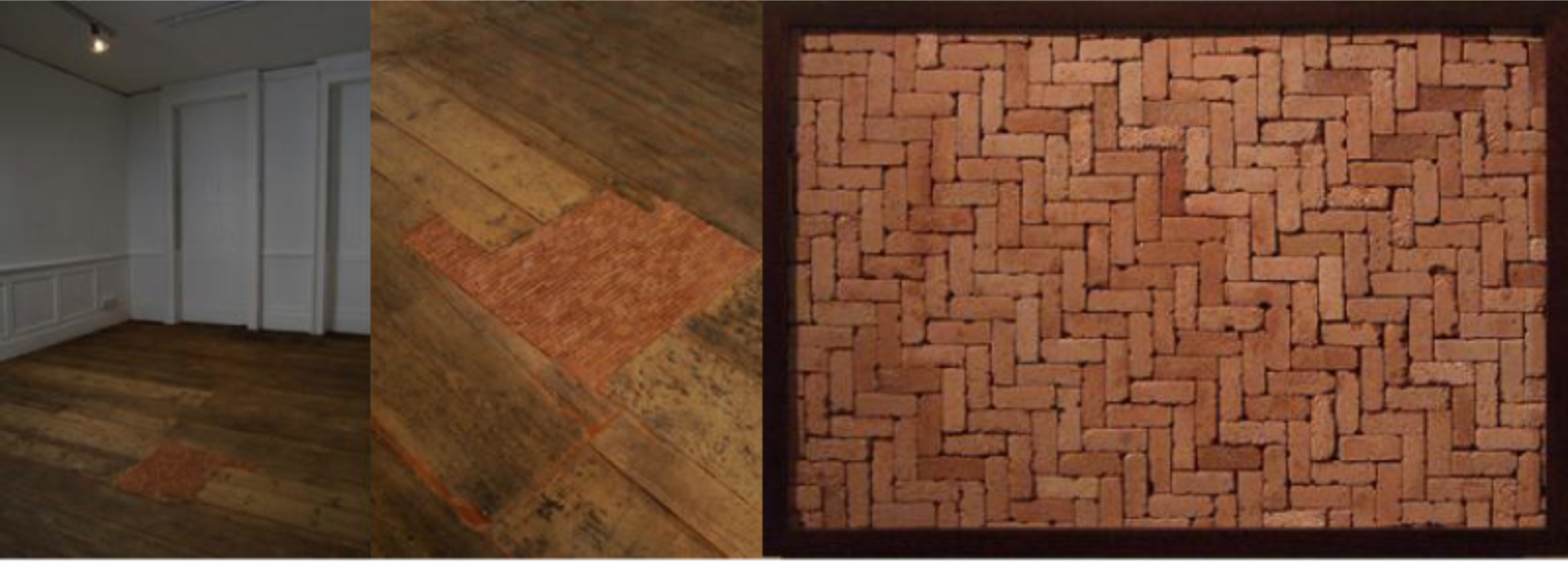
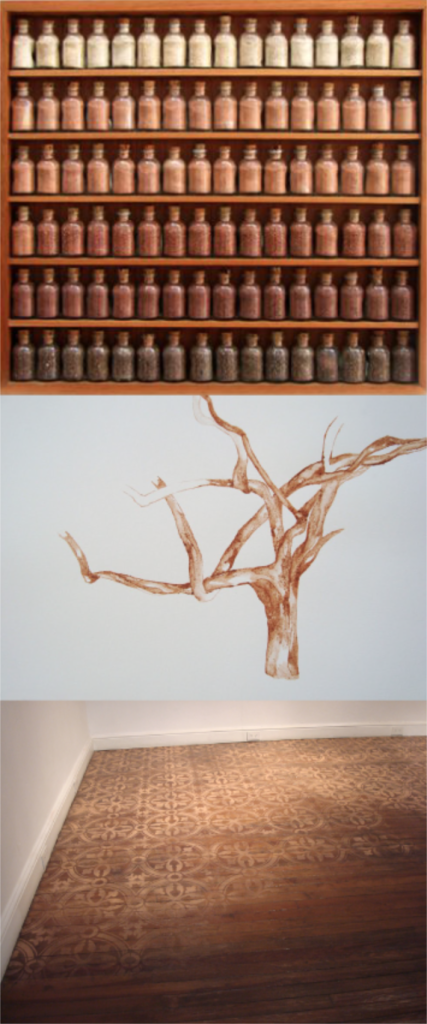 PM – You have often taken part of your house to the exhibition spaces, even when those were across the world. In a more recent piece, e agora toda terra é barro (and now the whole earth is made of clay), you travel to a pottery factory in Juazeiro do Norte (Ceará, Brazil) to make new bricks with the mixture of the powder of those bricks from your home and the muddy grand of Cariri4. You have also created a series after a trip to the Amazon Forest. What is the result of this interchange?
PM – You have often taken part of your house to the exhibition spaces, even when those were across the world. In a more recent piece, e agora toda terra é barro (and now the whole earth is made of clay), you travel to a pottery factory in Juazeiro do Norte (Ceará, Brazil) to make new bricks with the mixture of the powder of those bricks from your home and the muddy grand of Cariri4. You have also created a series after a trip to the Amazon Forest. What is the result of this interchange?
4 Translator ‘ s note: a region in me Brazilian state of Ceará.
BB – It is the memory of the differences among places, of the smells, of the time, The trip to the Amazon region was actually a project by Jarbas Lopes, who invited me to participate, as well as other people. It was the project of the São Paulo Biennial, which featured the theme “how to live together”. And so, we lived together, that is the best memory. We lived the present time, with no expectations regarding the exhibition (which Jarbas managed to conductvery well, in the sense of purely stimulating this experience). I remember the morning walks with Paulinha Dager and Léo. I remember the beard and the usefulness of Léo’s pocket knife, as well as meeting everyone, Guga, Wogler, Luiz Andrade. I remember the cornmeal cake that I used to bake for the group. Jarbas used to say that it was “the best hard cake he had ever eaten”. The science of crossing nets in the boat. our captain, the Amazon doctor, He knew everything about medicinal plants and was very helpful when Geraldo had that terrible earache. The little black man, with the experience of the river, canoes, fish cleaning. The fish, wow, so many! The riverside parties. The Sateré-Mawé5. The sound of the drum on top of the boat. a tribal sound, a return to the fullness of all senses, the sounds, the silence, the beauty, the myths, the howling monkeys. I would be talking endlessly about the best gift that I have ever received, of being on that boat to live.
5 Translator ‘ s note: a Brazilian indigenous tribe.
And then there was the project of going to the remote interior Of Brazil, to search for something that could be translated into the language of art. Then I went, after the drought and the landscape that I did not know. But I found a valley that is moist, rainy and full of plants, the Cariri, And we rented a car, Marcelo Campos and I. to look for the aridity I wanted to see what saddens people. And I thought about the differences of this place. A place where people pray for the rain and the weather becomes god. On the road, the rain was pouring nonstop, and I saw various ponds that were being formed, puddles, dams, Always around, there were the artisanal bricks workshops, and as they were strange constructions, resembling very ancient cities. There in the potteries I learned how to use the wooden tool, very simple, to make some new bricks which I mixed with a bit of the powder that I had taken with me. There was this interchange of lands, irregular, drying under the sun, and then brought it to the exhibition at Rio’s Caixa Cultural. Marcelo starts his text With a quote from Robert Smithson:
“the city provides the illusion that the land
does not exist”…

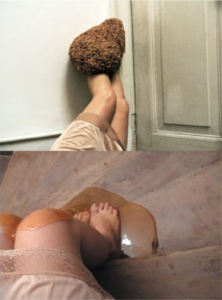 PM – Hybrid characters are quite distinct in your trajectory. The bottles in which dew is collected resemble beaks of birds or insects. The bee, the crab and the video Quando fui Carpa e quase virei dragão (When I was a Carp and almost turned into a dragon) are some examples of that. How does the fable work in your universe?
PM – Hybrid characters are quite distinct in your trajectory. The bottles in which dew is collected resemble beaks of birds or insects. The bee, the crab and the video Quando fui Carpa e quase virei dragão (When I was a Carp and almost turned into a dragon) are some examples of that. How does the fable work in your universe?
BB – My most initial pieces in the 90s were more direct and realistic. Afterwards my work started getting more fictional with the Coletas and Casa de Abelha. Lisette Lagnado wrote the text of the Maria Farinha catalogue with the title “Fiction Process” in 2004. Fables are short fiction stories that are usually related to the personification of animals, like the famous La Fontaine fables. I think they are also small myths. There is an incredible book that Cosack & Naify released in 2005 by Lévi-Strauss — it is called “From Honey to Ashes” —, I loved this book, which is actually a large catalog of the creation of myths in the Tropical Americas. The myths feature macaws, woodpeckers, jaguars and other tropical animals, honey and ashes to form the narratives… Characters such as the lady who is mad about honey and who lives in a bark emerge… This book helped me understand Casa de Abelha, I also think that this approach Of the animal-human universe is set aside for fables and mythologies. There is an excerpt from Freud’s “Civilization and its Discontents” that says that as we achieve a higher degree of civility, the less we notice the signs of some relationship with the animal world, in which we are inserted by classification.
The industry of perfumes and hygiene is becoming more sophisticated, and an aseptic behavior is keeping our natural odors further away, dampening the instincts… Well, this conversation goes far.
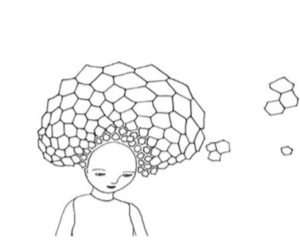
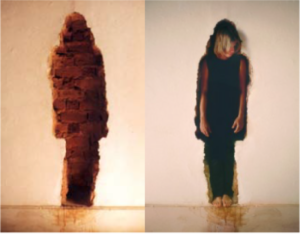 PM - A casa é reincidente nas suas criações. Tanto o vídeo como parte das fotos de Casa de Abelha foram realizados em sua antiga casa-atelier. Você retirou tijolos nesta mesma casa para criar outros vídeos, ações e Abrigo, um buraco na parede com a forma de seu corpo. Com os tijolos retirados, construiu torres, hortas até chegar no pó que você usa para desenhos e até mesmo, para criar mini tijolos. Me fale mais sobre o significado desse espaço, da casa nas suas obras.
PM - A casa é reincidente nas suas criações. Tanto o vídeo como parte das fotos de Casa de Abelha foram realizados em sua antiga casa-atelier. Você retirou tijolos nesta mesma casa para criar outros vídeos, ações e Abrigo, um buraco na parede com a forma de seu corpo. Com os tijolos retirados, construiu torres, hortas até chegar no pó que você usa para desenhos e até mesmo, para criar mini tijolos. Me fale mais sobre o significado desse espaço, da casa nas suas obras.